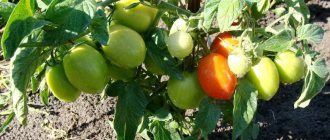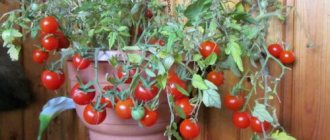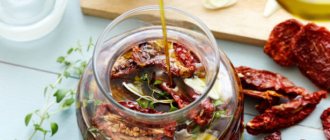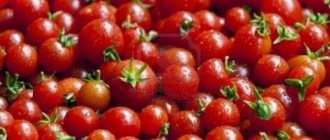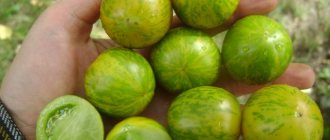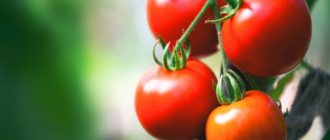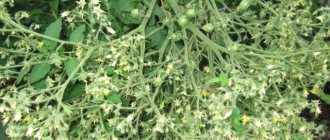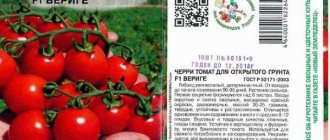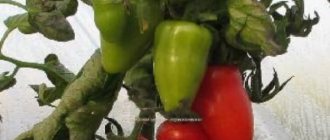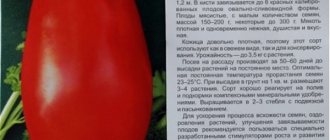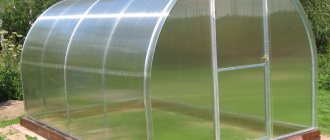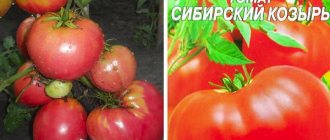General information about culture
The variety is considered a hybrid, so it is not recommended to collect planting material yourself. The stems of indeterminate Date species grow to a height of 1.8 m. Low-growing varieties form small compact bushes 0.5-0.7 m high.
The fruits of the Date variety are compact in size and elongated in shape, reminiscent of a date. The taste is predominantly sweet, with some fruity aftertaste. Tomatoes retain their taste perfectly for one and a half to two months, but vegetables should be placed in storage containers along with the trusses.
Advantages and disadvantages
High yield is the main advantage of Date tomatoes.
However, tomato has other benefits:
- cold resistance;
- strong immunity to diseases;
- long fruiting period;
- tomatoes have a pleasant sweetish taste with soft fruity notes;
- the fruits are well stored. If the right conditions are provided, the harvest can be saved for a month or a month and a half without loss of taste;
- fruits are well transported over long distances;
- simple crop care.
When growing Date tomatoes, you need to take into account some of the disadvantages of the variety: a reduction in the formation of ovaries in the event of a prolonged cold snap, late ripening periods - the first fruits ripen in the second half of July.
Varieties and description of varieties
The hybrid tomato Date has several subspecies. When growing them, you need to take into account their distinctive features.
Date red
Brief characteristics of the variety: resistance to diseases and low temperatures. Semi-determinate bushes grow up to one and a half meters high. Therefore, the plant needs to be tied up. Experienced gardeners recommend forming a bush into two stems. You need to start sowing seeds two months before the planned planting of seedlings in the ground.
Unusually tasty red oval-shaped tomatoes ripen weighing 20-25 g. Up to 18 fruits are tied in a brush. Tomatoes are great for drying and preparing fresh salads, and are convenient for canning.
See also Bobcat tomatoes: description and yield of the variety, features of planting seeds
Yellow
The hybrid is excellent for growing in open beds and indoors. The stems are weakly leafy, grow to a height of up to one and a half meters and require staking. This is a medium-late ripening variety. To get a good harvest, it is recommended to grow bushes with 3-4 stems.
Expert opinion
Stanislav Pavlovich
Gardener with 17 years of experience and our expert
Ask a Question
Advice! Pruning of Date Yellow tomato bushes is done up to the first cluster, which ensures high-yielding fruit set.
Yellow dense glossy skin is a feature of Date Yellow tomatoes. The fruits do not crack in any weather and are suitable for preparing fresh salads and canning. The shelf life of ripe tomatoes without loss of taste is two months.
Sweet
Tall dates are planted in greenhouses and open garden beds. To increase productivity, it is important to provide conditions for reliable fixation of stems growing to a height of 1.8-1.9 m. The approximate arrangement of holes is 0.5 m for the distance between bushes in a row and 0.7 m for the distance between rows.
The growing season is about 4 months, so it is recommended to sow seeds in March. Seedlings are planted in greenhouses from the second half of May. The beginning of June is a suitable period for planting seedlings in open ground.
A distinctive taste with notes of raisins and sweet plums is a distinctive feature of Date Sweet tomatoes. The fruits ripen small, weighing 20-25 g.
Siberian F1
The early ripening variety is planted in greenhouses and open beds. Due to the fact that the stems do not grow higher than 0.5-0.7 cm, the plants can be grown in apartment conditions (on the balcony, on the windowsill). From the end of February you can start sowing seeds in fertile neutral soil mixtures. The seedlings are planted in a permanent place of growth approximately one and a half months after germination of the seed.
The plum-shaped fruits ripen weighing 20-22 g. Appetizing red tomatoes look great in salads and beautifully decorate preserves.
Orange
The tomato variety is a late-ripening variety. Fruiting clusters grow on tall bushes (each bears 18-20 fruits weighing 20-22 g). The green mass of the bushes is formed by small foliage. Since the fruits ripen small, gardeners recommend leaving 3-4 stems in the bushes.
No voids are formed in the fruits. The skin of tomatoes has a honey-yellow hue; it is quite thin, but does not burst when the fruit ripens. Thanks to the balanced combination of sourness and sweet notes, tomatoes perfectly complement the taste of fresh salads.
How to grow seedlings?
Date tomatoes are recommended to be grown in seedlings. Sowing is carried out 60 days before planting the seedlings in the garden plot. The seeds are disinfected and brought to maturity.
For sowing, use a soft and fertile soil mixture. Universal soil from “Morris Green”, biosoil “Ecoflora” with the addition of sapropel are suitable.
The soil is left in a warm room so that it warms up well. The soil temperature for sowing is 23 C. The container is filled with soil mixture and watered with Fitosporin solution, 5 g/l. The soil is compacted, sprinkled with ash, grooves are made in increments of 1.5-2 cm, 1 cm deep.
Plant the seeds and cover with soil. A greenhouse effect is created for seedlings. The container is covered with film and left indoors at a temperature of 23-25 C.
More on the topic: What care does the Blagovest tomato need?
The film is lifted daily. Shoots appear in 10-14 days. If you treat the seedlings with Epin growth stimulant solution, the sprouts will grow earlier, in 5-7 days. For seedlings, a certain microclimate and daylight hours are organized.
The container with the sprouts, which have not yet completely emerged from the soil, is cooled. To do this, the temperature in the greenhouse is reduced to 15-17 C. A fluorescent lamp is installed above the seedlings.
It should function for 24 hours. Turn off the lighting device when the cotyledons completely emerge from the soil. Plants begin to adapt to day and night modes.
The length of the night is increased gradually. By the end of the month, the day should last 12 hours. At this time, the temperature is raised to 19-20 C. If this regime is observed for growing seedlings, its root system is well formed, leaves and stems develop. The bushes do not stretch.
At the stage of 2 full leaves, the seedlings are picked. Before planting in the garden plot, the seedlings are adapted to the new microclimate. Plants are hardened off within 2 weeks. The seedlings are transferred to the ground when the air temperature rises to 19 C.
If the air temperature drops significantly at night, the greenhouse is covered with thermal insulation material. For plants in open ground, it is recommended to equip a film tunnel.
Recommendations for cultivation and care
The Date tomato is undemanding in care, therefore, to obtain a bountiful harvest, it is recommended to adhere to the general rules of agricultural technology for growing tomatoes:
- seeds are sown from the first days of March (more precisely, the period is determined by the weather conditions of the region). As soon as the weather is warm outside (air temperature 15-20°C), the seedlings are planted in open ground;
- when the seedlings get a little stronger and grow, the stems are tied to trellis supports;
- Date tomato loves moisture, so the soil is not allowed to dry out;
- fertilizing is applied twice a month. Both organic and mineral compounds are used.
See also Rules for growing and characteristics of the Pink Spam tomato
The beds are weeded regularly. The soil around the stems is loosened carefully so as not to damage the root system of the plants. It is advisable to mulch the soil so that the soil retains moisture longer.
Planting seeds
The boxes are filled with sand, peat, garden soil with the addition of superphosphate, potassium and ash. If you prepared the mixture yourself, then fry it for an hour in the oven at 200 °C to eliminate pathogenic fungi and bacteria.
Seeds are sown in boxes in early March. First, put it in a gauze bag and lower it for 20 minutes. into a solution of 1 teaspoon of potassium permanganate and 1 liter of clean water. Seeds are planted in the soil to a depth of 1 cm.
See also
Characteristics and description of the Sanka tomato variety, its yield and cultivationRead
Water the plantings with a spray bottle and cover with film. Before the first shoots, it is necessary to place the boxes in a room with an air temperature of about +23 °C. When sprouts appear, remove the film.
When 1 - 2 true leaves grow, plant the seedlings in separate peat cups. Be sure to extend their daylight hours by illuminating the tomatoes with lamps.
Fertilize for the first time 10 days after emergence. Pour 100 g of bird droppings or 300 g of manure into a ten-liter bucket of water. Leave it for a day. After a day, water the seedlings at the roots, being careful not to get them on the leaves, as this can cause burns.
60 - 65 days after sowing the seeds, growing seedlings continues in open ground or in a greenhouse.
Nuances for open ground and greenhouses
When growing tall tomatoes in open ground, you can use a horizontal trellis. In greenhouses, the optimal support option is a vertical trellis - it is easier to attach rope garters to the frame.
The Date tomato is slightly affected by tomato diseases (late blight, white and gray rot). But when growing in greenhouse conditions, more attention is paid to prevention:
- at the end of the season, the top fertile layer of soil is renewed;
- the soil in the greenhouse is constantly loosened and the beds are mulched;
- the building is regularly ventilated and watered according to a certain schedule.
When watering bushes in open beds, you need to take into account weather conditions: in rainy times, watering is reduced, the beds are loosened more often and always covered with mulch.
Harvesting and application
A long fruiting period is an important advantage of almost all Date tomato varieties. Naturally, in greenhouse conditions it takes longer to collect ripe fruits. Tomatoes are a great addition to fresh salads. The fruits are canned (pickled, pickled) and frozen.
Typically, harvesting begins in July and ends in September. The clusters bear 6-20 small fruits (determined by the Date tomato subspecies). Tomatoes on a bunch ripen at the same time and are firmly attached by the stalk. Therefore, usually when harvesting, individual fruits are not picked, but the cluster is cut off completely. Tomatoes do not crack, are well stored and transported.
Red date tomato
In addition to the yellow variety, Russian breeders also developed a red date hybrid based on cherry tomatoes. It is similar to the yellow hybrid both in terms of cultivation and the appearance of the fruit. The red date belongs to the semi-determinate type with medium ripening periods.
It takes root in greenhouse conditions in warm and temperate climates. It is resistant to dangerous diseases such as late blight and tobacco mosaic. The culture requires mandatory gartering and pinching. To increase productivity, plants are formed into 2 or 3 stems.
Ripe red date tomatoes are practically no different from yellow ones. Perhaps they do not have such a high sugar content, so they are less sweet.
They are used mainly for fresh salads and cocktails; they are stored for a long time without losing their presentation.
